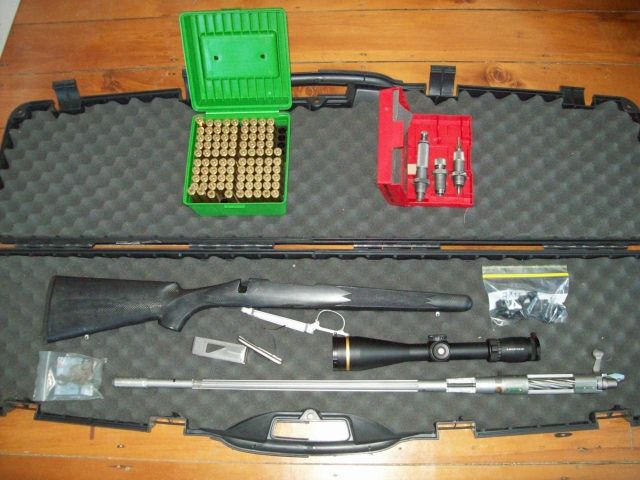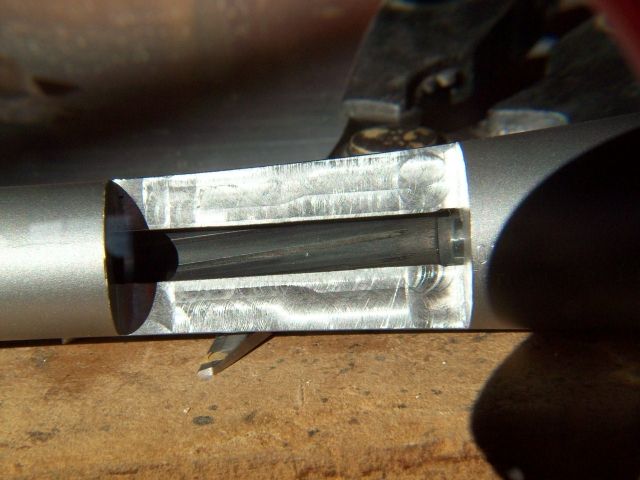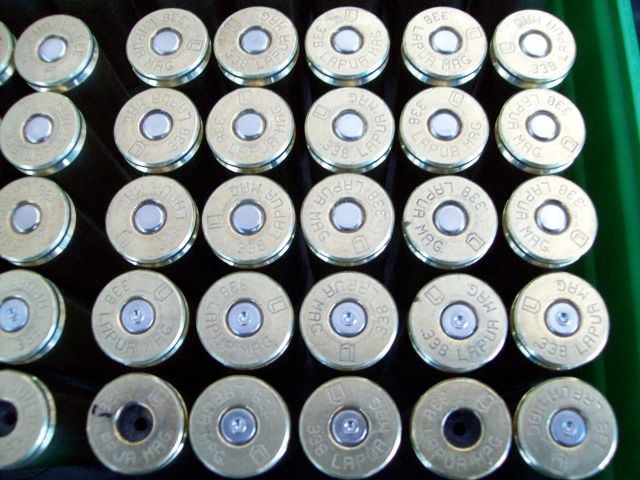Just two clear things up......
OK so this may well be my last post, I may get banned, Ive been threatened with getting sued, and Ill probably loose any respect I had but if i save some one a bolt two the head its worth it for me.
As most will no Iv been a long time supporter of KG, I brought a 300 earlier in the year, real nice bit of kit
I had concerns that I raised on more than one occasion about it being two hot and stamping brass, I even sent it back only two be told it was sweet, this guys nos way more than simple framer I thought....
Anyhow along comes something that I just had two have, up for sale goes the 300 and sold.
The purchaser on inspecting the brass asked if I had reloaded for it, Which I hadn't KG did all the loading.
He then asked KG two to redo load development as he was unhappy with the stamping and would not fire it.
Unfortunately the gun builder just thought the whole thing was a setup and so did some others.
Obviously Ive tried repeatably two settle this behind the scenes but have been told by KG two go take a jump.
I thought I might get slightly better service being a big client, he did offer two re barrel the gun but buy then no one wanted a 300.
I'm $5500 out of pocket for this gun, and having two buy it back from the new owner will leave me more out of pocket.
Any how that's the facts guys take it how you will.
Please be safe out there, if Ive learn't one this its that a few extra scope clicks never killed anyone.
Here is one of the reports on the gun.
300 Rifle and Ammunition Evaluation
Rifle Evaluation
Firstly evaluation with the bore scope showed a seriously fire cracked throat that we would consider shot out, and would expect to have fired in excess of 300 rounds of a very over bore cartridge loaded to maximum 65,000psi pressures. See photos. This fire cracking continued 10 inches or so down the bore.
The barrel flutes are 92 thou deep, leaving a core/wall thickness of 92 thou, that’s about 2 mm. The barrel makers who are prepared to push core thickness like Tim North from Broughtons tell me they won’t go less than 150 thou. We’ve accidently tried it as thin as 100 thou, and got lengthwise stress cracks and the throat/barrel gave up the ghost early due to the extreme flexing under peak pressure - that was in a TrueFlite barrel. Now Remington’s steel may be better stress relieved and softer, so may stand it for longer, but those extremely deep flutes that finish abruptly with no runout are creating real fracture points and asking for trouble in our opinion.
The flute depth was also not consistent, and varied by 24 thou in depth around the barrel.
The M16 extractor has been incorrectly fitted and it is sitting proud of the bolt diameter and must have been dragging in the front receiver ring. So instead of refitting the extractor at the correct depth, or taking a cut across it to bring it back down to flush, the front receiver ring has been bored out from the front to get it to clear, reducing the height of the lug abutments and the locking lug surface area, and removing the very section that is s’posed to hold the front of the bolt in alignment. There is about 14 thou aside of clearance, and the bolt rattles around in there like the proverbial …. in a sock.
Then a huge clearance has been bored around the bolt nose in the barrel counter bore, creating a ridiculous 62 thou of clearance right round the nose. The counterbore has also been bored too deep, with 54 thou of clearance on bolt nose, needlessly increasing the amount of unsupported case poking out of the chamber. Both these clearances are ideally kept to a minimum - so much for the Remington three rings of steel!
The barrel has been set back maybe a few hundred thou, and there is a large tenon thread runout groove, and combined with the undercutting of the rear section of the tenon thread with the oversize bolt counterbore, its effectively left only about .375” of properly supported thread length to hold the barrel in. The barrel was barely hand tight, possibly due to the small amount of real thread contact left settling a little under the excessive pressures it’s been subject to.
With the machined tenon and muzzle running true, the chamber and bore runs out significantly by about 4 thou at the front but only 1 thou at the rear. So it is neither parallel nor in line.
Ammo Evaluation
The powder charges weighed 111.2gns, plus or minus .1gns. The BTO’s varied 11 thou from long to short. The total cartridge runouts averaged 8 thou. The headspace varied 3 thou. The BTO was a 40 thou jump, so more than generally recommended, but may have started off about 10 or 15 thou and the throat may have lengthened.
Pressure/velocity test:
3130fps av for 71,500psi av, 35fps ES.
Average group size 1.5 inches.
Had to drop to 107.5gns of Re50 to get a safe 3040 fps for 65,000psi av.
Then tried US 869, #2064 did 3150fps for 65,000psi, just as it does in our 300 FX, #2066 did 3100fps for 65,000psi.
Rifle didn’t shoot any of the loads well, but shot tightest with the 869 load but still lost the odd shot as we’d expect looking at that throat.
If loaded to a genuine 3175fps with Re50, the pressure would have been in excess of 75,000psi and that may well be where the throat has gone. We fired 15 rounds total in our evaluation.
Welcome guest, is this your first visit? Create Account now to join.
Welcome to the NZ Hunting and Shooting Forums.
Search Forums
User Tag List
Closed Thread
Results 1 to 3 of 3
Thread: The 300, my story
-
27-09-2014, 03:07 PM #1
The 300, my story
-
-
29-09-2014, 02:28 PM #2
Ok here is the full story.....
I am the one that ended up buying the 300 Terminator.
When I recieved it I gave it a quick look over and it looked to be a nice bit of kit, the only thing I wasn't sure of was that some of the brass had ejector stamp marks on it. My personal opinion is to err on the side of caution when it comes to Lapua case heads in Remington actions so I decided not to fire it. I made the decision to send it to NZ Hunter to re do the load work, I trust NZ Hunter in there load work and I know they have tons of experience with Lapua based wildcats, so off it went.
The day it arrived at NZ Hunter I got an email from Greg Duley telling me they have looked down the barrel with a bore scope and the barrel is near shot out. Since I had been communicating with Brads about the rifle I let him know what the story was and I think he was feeling a bit gutted that he had sold it to me based on the fact that it had only fired 60 rounds and the barrel was buggered.
That night I rang Kiwi Greg and explained what had been observed, to KG's credit he immediately offered to replace the barrel if I sent it down and he agreed on its condition. I decided not to accept this offer as I had a spare 7mm barrel sitting at NZ Hunter which I intended to have fitted at my cost insted.
A week or so later I was advised by NZ Hunter of some other issues with the rifle (which are already laid out on the first page of this
thread) Again I advised Brads of these issues. Brads took it upon himself to try to get his money back from KG so he could reimburse me for the rifle.
A few days later I got the feeling that things were not working out between KG and Brads, and due to a lot of second hand information floating around the place I decided to contact Kiwi Greg myself.
After explaining to KG what the guys at NZ Hunter had found KG didn't hesitate to offer a resolution. An agreement was reached where KG would buy the rifle from me for what I paid for it leaving no one out of pocket.
So as it stands right now I have been paid by KG and the rifle is on the courier back to him.
I was really hoping this whole issue would be resolved without needing to be aired in public and the truth is that the issue was resolved between myself and KG last Wednesday before this came out here. I don't think the shit fight that we have here now is nessacery and it's one that's going on with very few facts.
Hopefully that clears a few things up. I have tried to be impartial here and not let past relationships get in the way of the facts.
In my opinion I hope this thread ends here as it's the end of the matter as far as I'm concerned.
-
02-10-2014, 10:05 AM #3
Good morning all,
Sorry for the late reply but I have been busy with the aftermath of the Sika show and we have school holidays again where my daughter and I hunt when the weather allows. Also I did not see any point in commenting on this shambles until I had the rifle back for examination, so apologies for those only digesting half of this story and going off half cocked.
So....... This rifle chambered in 300 Terminator had 134 rounds through it during load development and Long Range testing before it was shipped to brads in January, also supplied was approx 100x more ammo and then another 65 reloaded in May.
All the brass supplied was used in Load Development and that included some that were stamped as you get when finding the upper limit in a cartridge such as this with no load data available.
The rifle shot very well when it went to Brads and most likely was still shooting very well when he sold it for $3000 complete with a new VX6 3-18-50 illuminated with alumina caps, approx 95 loaded ammo and dies.
LR purchased the rifle from this second owner for $4000 complete still wrapped up unused since brads sold it, a bargain !!!
LR was not comfortable with the look of some of the brass, and sent it to NZ Hunter for load development.
GD proceeded to dismantle the rifle and pick it to bits as any competitor can to another's products, which was foreseeable and had been mentioned to others, including Brads weeks before the event.
My Gunsmith is confident that the rifle is safe.
The rifle went to NZ Hunter with approx 95x loaded ammo.
GD has been trying to get Reloader 50 powder since January 2013 with no luck as only six 8LB containers came into the country, and when I received the rifle back the ammo had been dismantled and only the brass and 3 projectiles included, and only one of the projectiles was mine (being HBN coated)
GD has now used the powder to test in his own version of the 300 Terminator.
Conveniently or inconveniently (depending on your position) the barrel cannot be fired now as it has been milled open to expose the throat area (which a bore scope can achieve without damaging the barrel) and has knowingly rendered it useless.
Myself and many others are confident the barrel, with visible fire cracking only travelling half an inch from the throat end is far from shot out and could easily have been polished and continued to be used.
To myself and several others who have viewed the brass and barrel etc it seems there is little wrong with them and certainly not to the extent mentioned in GDs report and I have already had offers for its purchase.
If you are local and wish to view and discuss the rifle parts mentioned here please feel free to contact me, there is nothing to hide here.
The complete rifle is in negotiation to go to a qualified gunsmith in the near future for a proper report from a QUALIFIED GUNSMITH.
I am extremely happy to have paid LR what he paid for it, $4000
I got back......
Mc Millan Carbon Hunters Edge stock
Milled out barrel
Trigger
Extended Mag box
Bottom Metal
Action and bolt
T2 Terminator Brake
Talley Rings
95x brass still primed
3 projectiles and dies
And a lovely Leupold VX 6 3-18-50 illuminated with Alumina caps
Some pics........

Sectioned barrel

Sectioned throat

“Over loaded” brass
 Contact me for reloading components, brass, projectiles, powder, primers, etc
Contact me for reloading components, brass, projectiles, powder, primers, etc
http://terminatorproducts.co.nz/
http://www.youtube.com/user/Terminat...?feature=guide
Similar Threads
-
Anyone know this story?
By Pengy in forum HuntingReplies: 8Last Post: 23-05-2014, 02:00 PM -
This should have been Ben's story
By Spook in forum The MagazineReplies: 15Last Post: 08-11-2013, 10:42 AM -
Their story!!
By stingray in forum The MagazineReplies: 5Last Post: 11-06-2013, 10:56 AM
Tags for this Thread
Welcome to NZ Hunting and Shooting Forums! We see you're new here, or arn't logged in. Create an account, and Login for full access including our FREE BUY and SELL section Register NOW!!





 16Likes
16Likes LinkBack URL
LinkBack URL About LinkBacks
About LinkBacks







Bookmarks